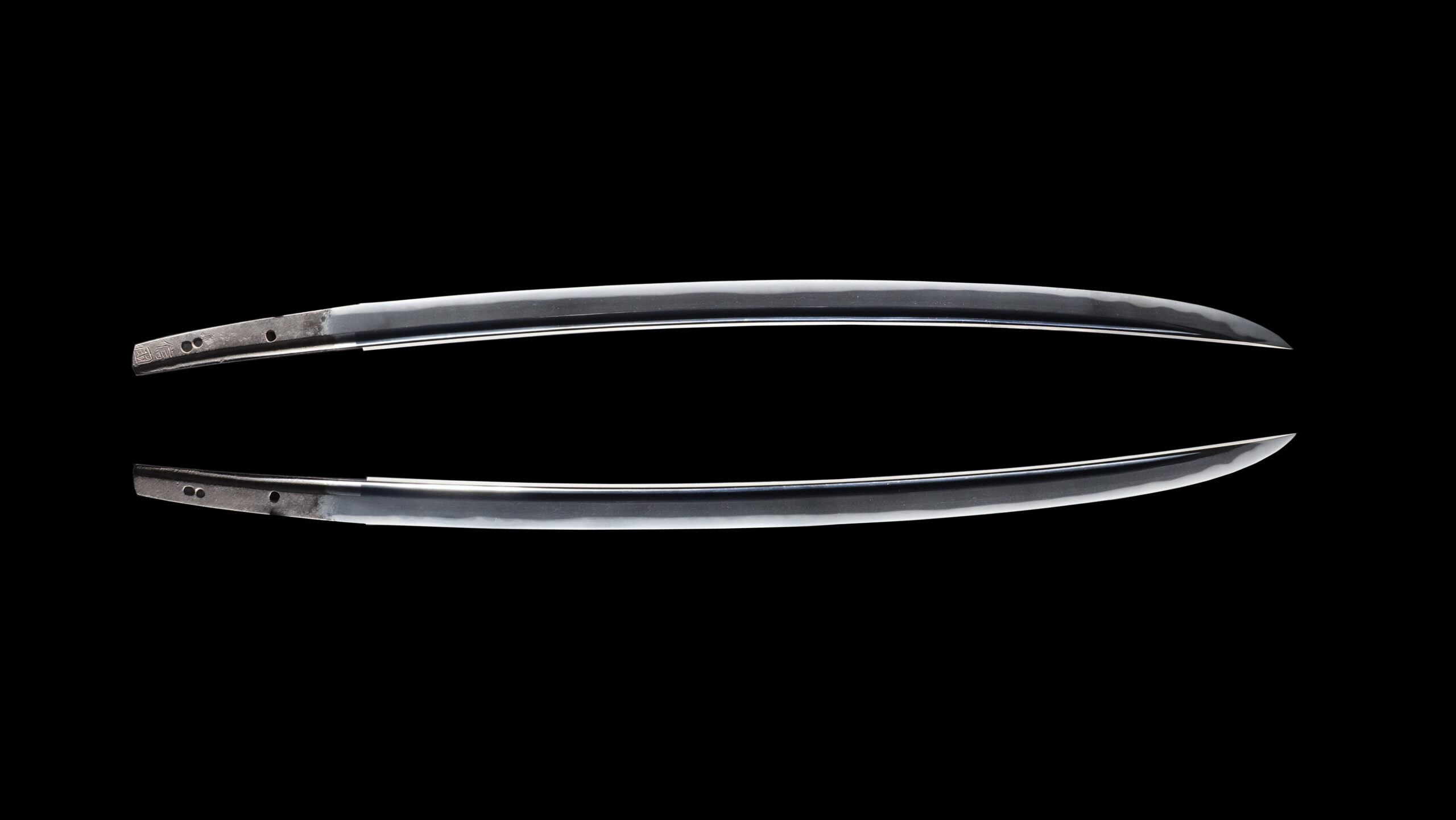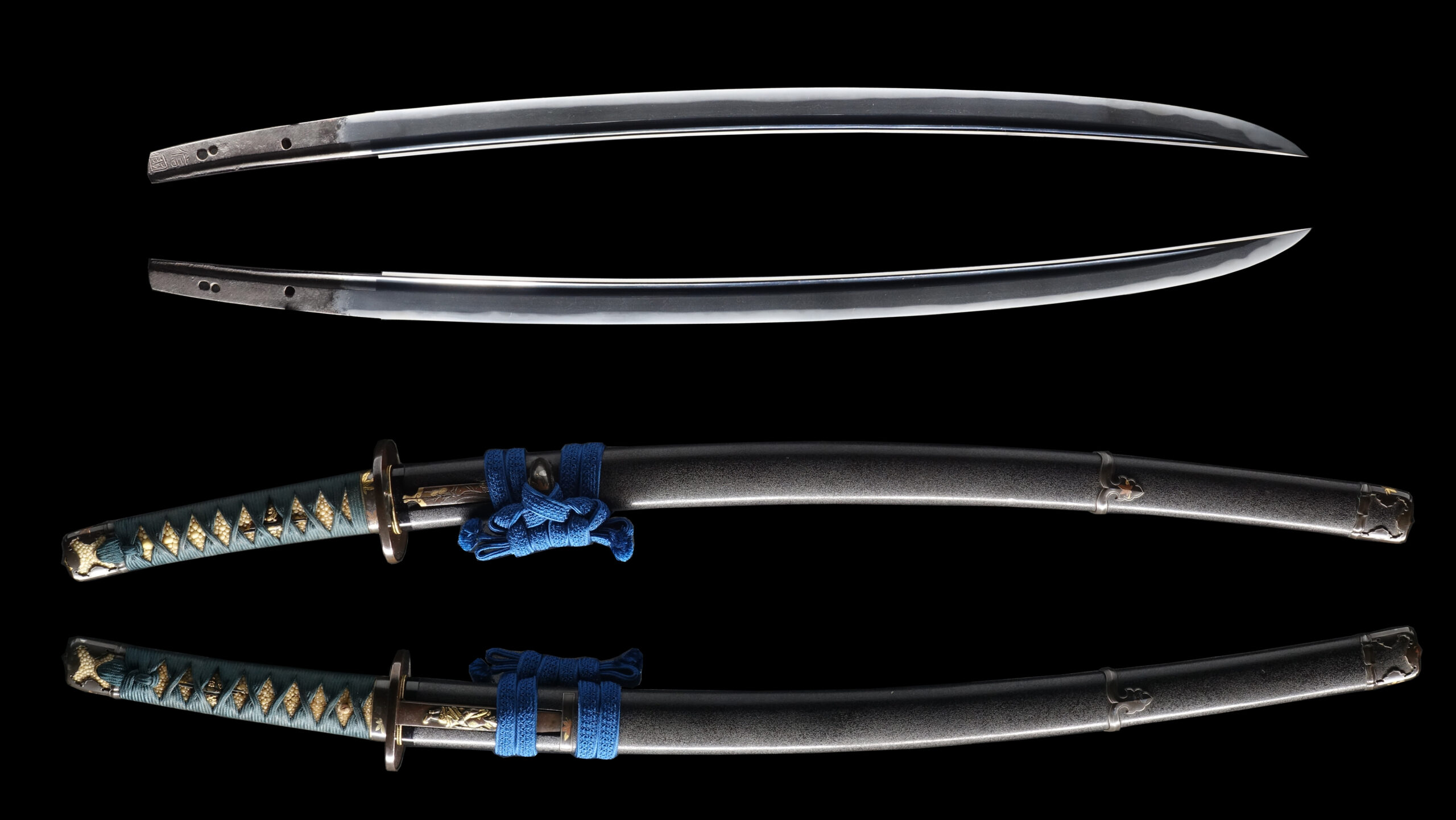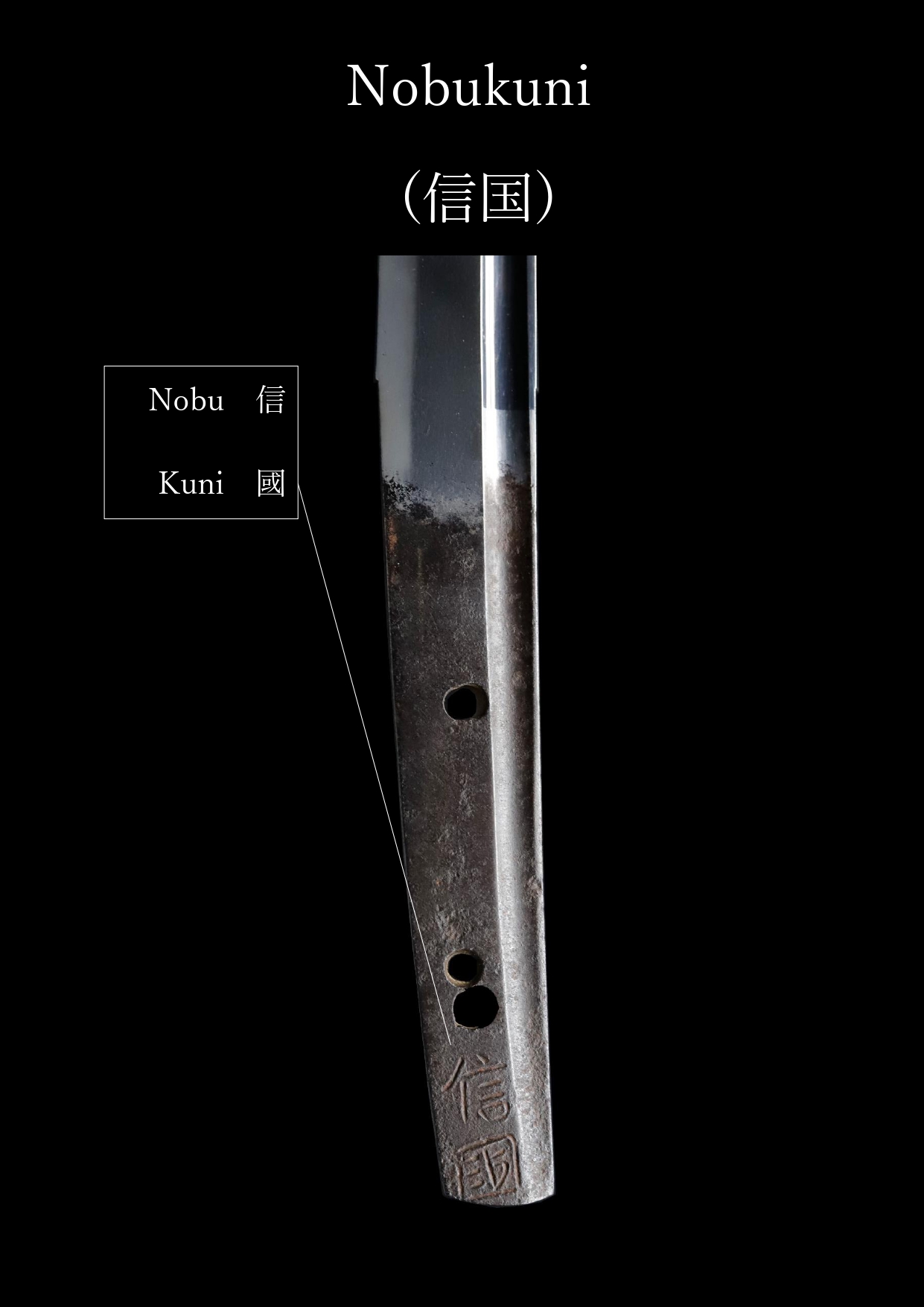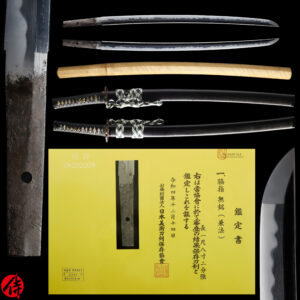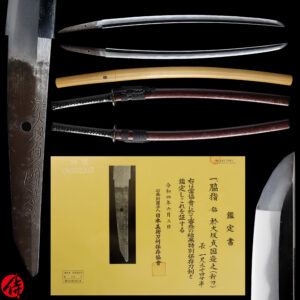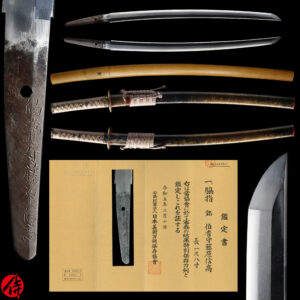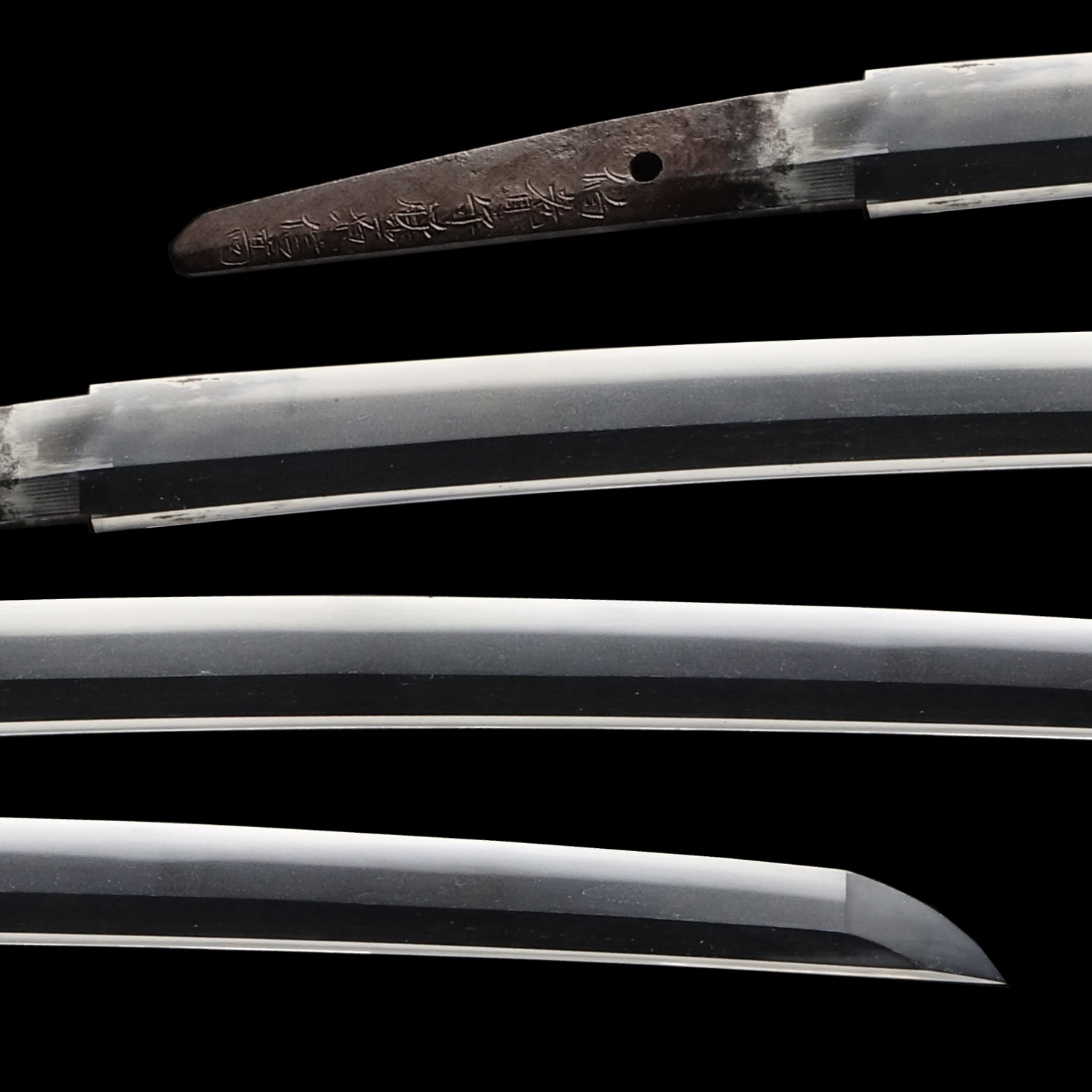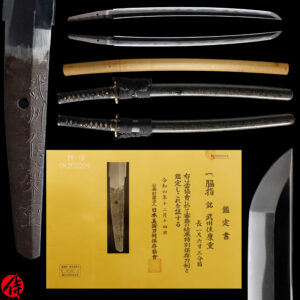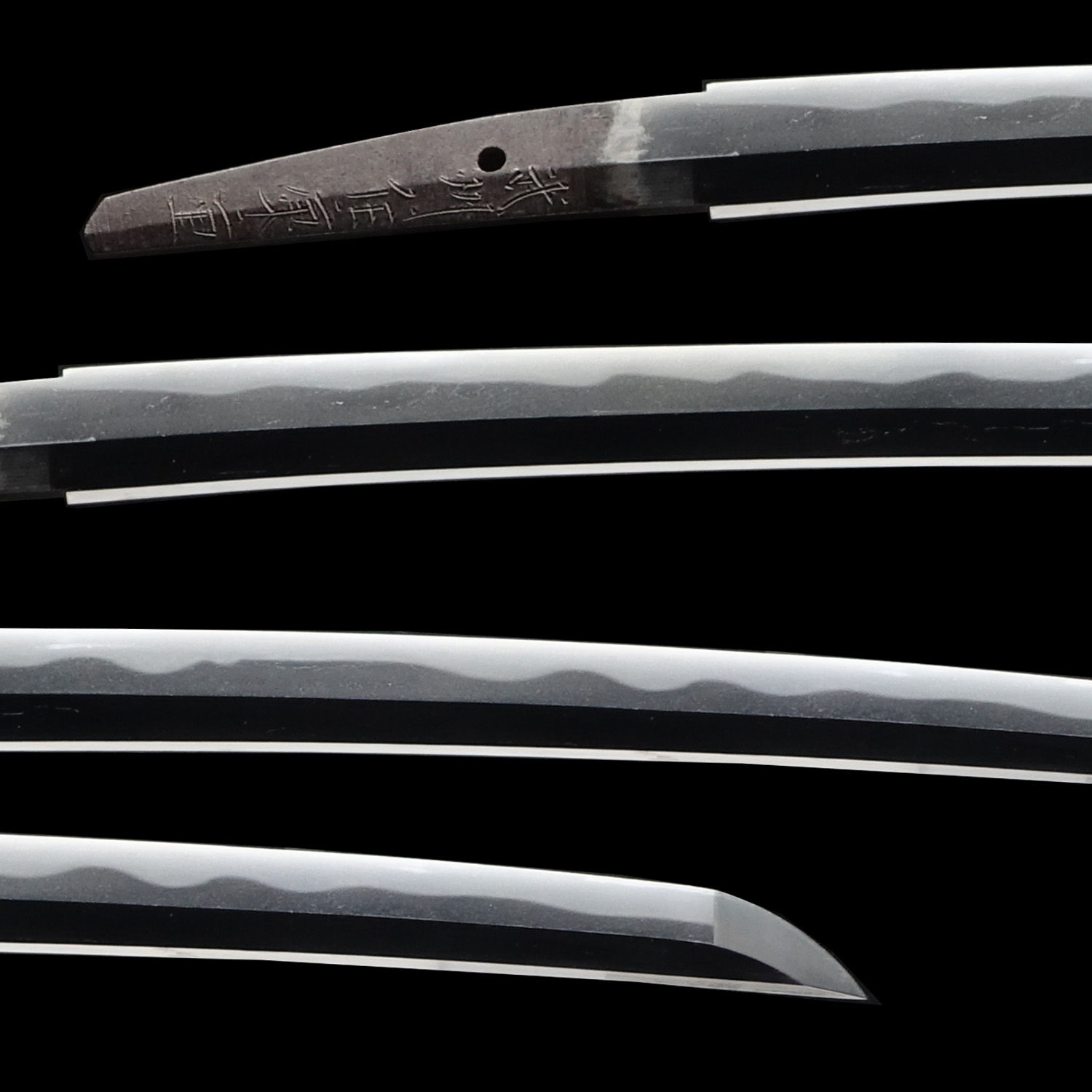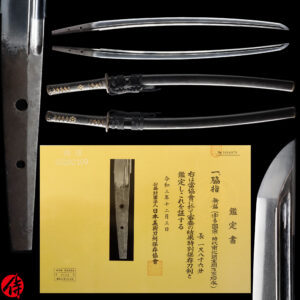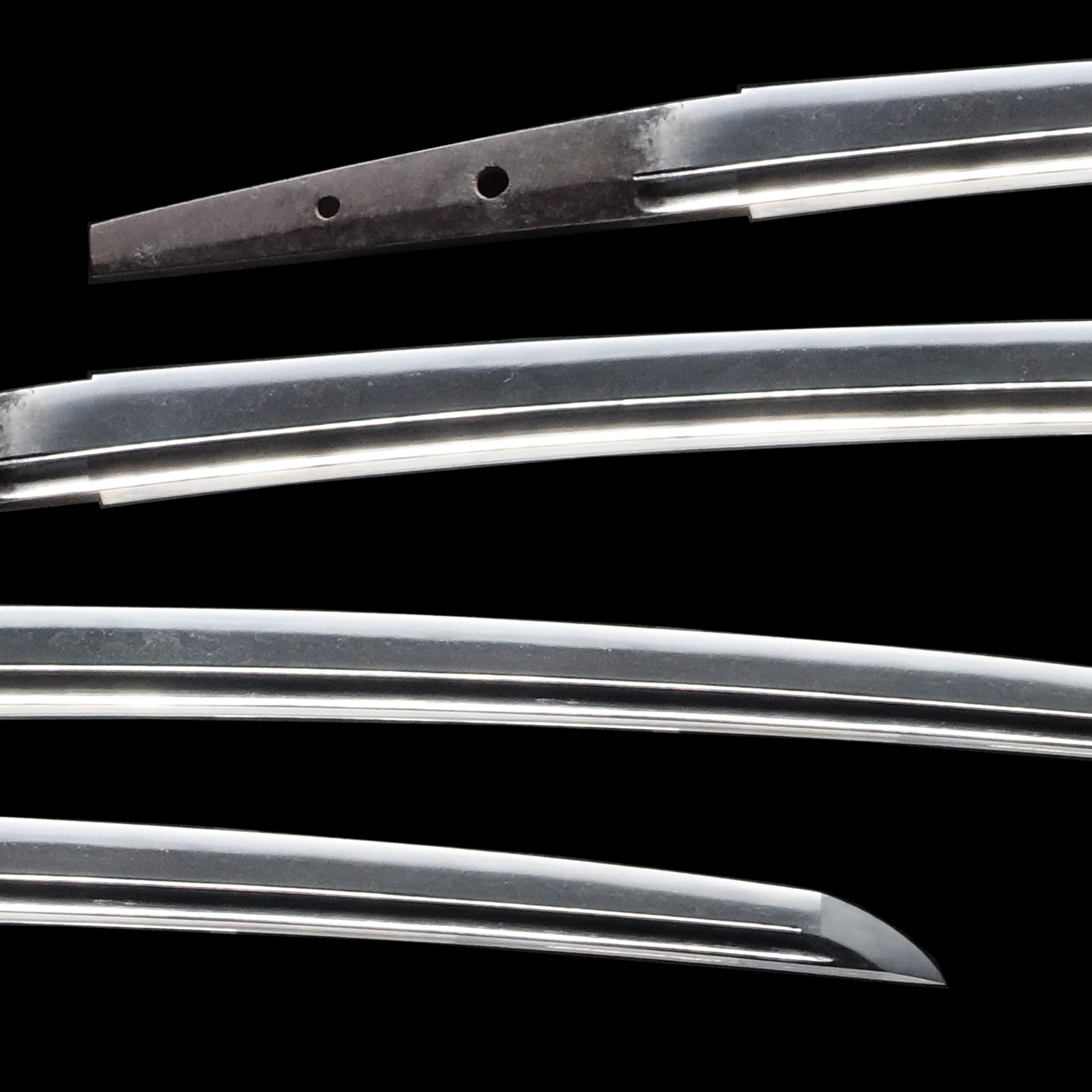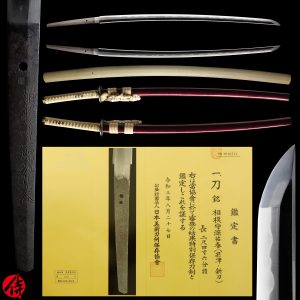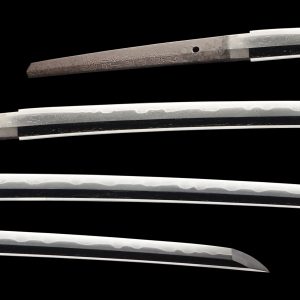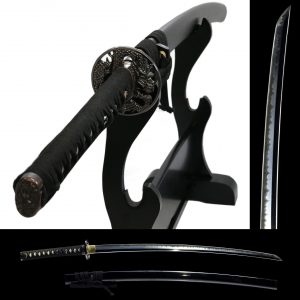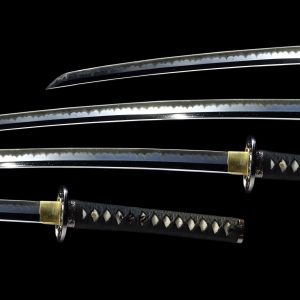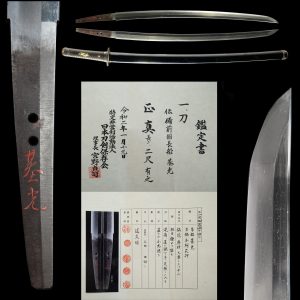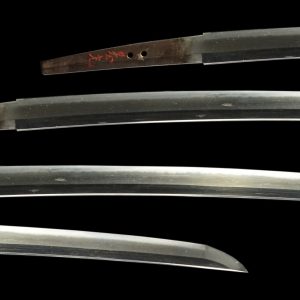Antique Japanese Sword Wakizashi Signed by Nobukuni with NBTHK Hozon Certificate and Hozon Tosogu
【Description】
Summary
This blade was signed by Nobukuni (信国) during the early Muromachi period (early 15th century), according to its NBTHK appraisal. The maker’s name, Nobukuni, lasted six generations in Yamashiro province (today’s Kyoto prefecture) during the Gen-Ou~O-Ei era (1319-1428: Nanbokucho-Early Muromachi period). There were also branches of Nobukuni schools in other parts of Japan, such as Buzen, Chikuzen, and Echigo.
The first-gen Nobukuni became an apprentice of Ryokai during the second year of the Gen-Ou era (1320), and he started to sign Nobukuni a few decades later. He was a grandson of Ryokai Hisanobu, who was a renowned maker in Ryokai school. Also, some records suggest that the first-gen Nobukuni also learned sword-forging techniques from Sadamune. Based on its appraisal, we believe the late-gen Nobukuni made this blade.
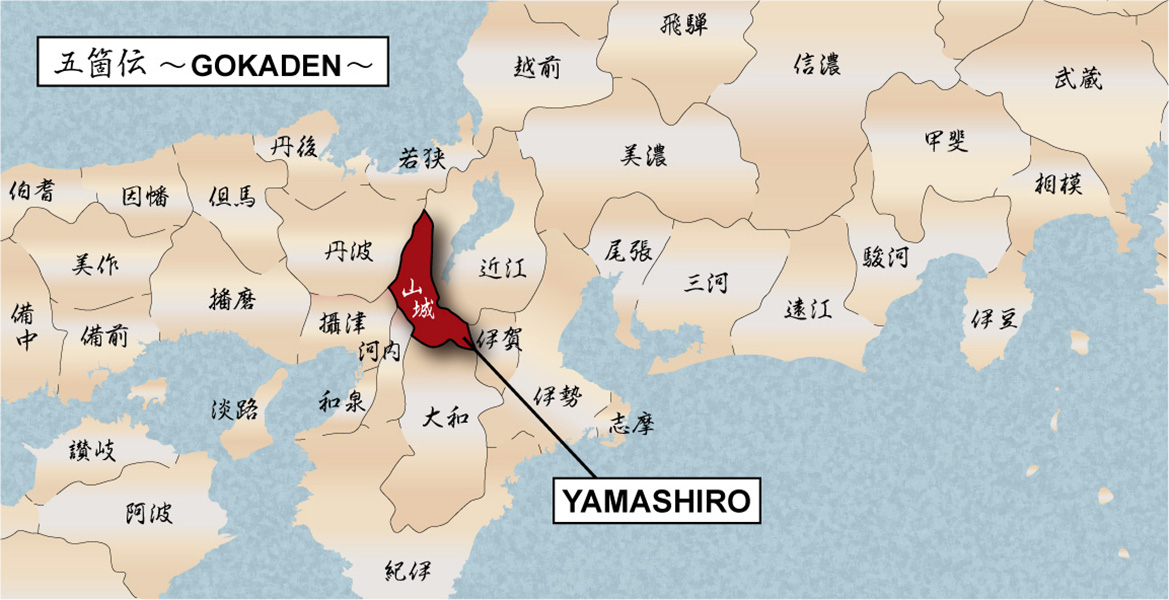
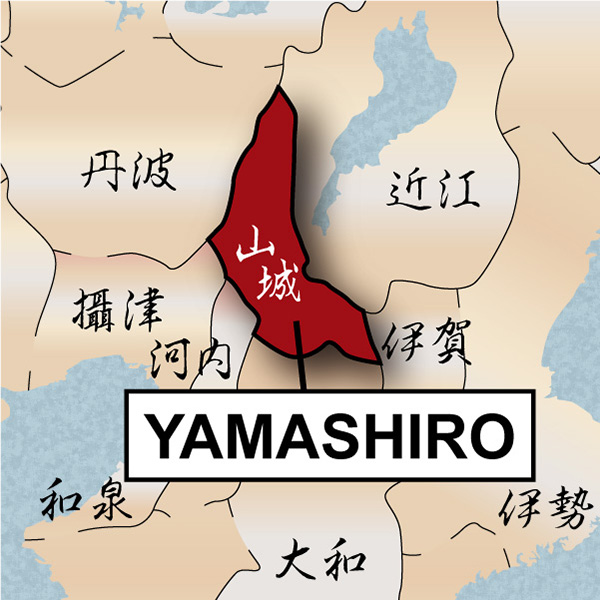
Ryokai School
Ryokai was a swordsmith from the late Kamakura period in Yamashiro Province(Today’s Kyoto). It is said that he was a son of Rai Kuniyuki (来国行) and a younger brother of Rai Kunitoshi (来国俊). Both of them are renowned swordsmiths throughout Samurai history. Ryokai founded his school, and the apprentices were allowed to use Ryokai in their maker’s names. Ryokai’s son was Ryokai Hisanobu, who took over the school.
Yamashiro Den
Yamashiro province was famous for its sword-making style called YAMASHIRO-DEN. YAMASHIRO-DEN’s origin dates back to the Heian period(794 A.D) when the capital city was moved from Nara to Kyoto. The swordsmiths in Yamashiro province initially prospered by forging swords for court nobles and imperial families. Later on, they also forged swords for feudal lords after the Samurai military government took control of Japan. There are so many renowned swordsmiths from this region.
It is said that the founder of YAMASHIRO-DEN was Sanjo Munechika. And there are four prestigious main branches in this region. They are Sanjo, Rai, Nobukuni, and Awataguchi.
One of the characteristics of YAMASHIRO-DEN is its elegant design and beautiful Jigane (steel surface pattern).
Shobu Zukuri (菖蒲造り)
You can see interesting Kissaki (tip of the blade) called Shobu Zukuri (菖蒲造り). There is no Yokote on this blade. Yokote is the borderline between the tip and cutting edge. We are confident you will appreciate the elegant look of this blade.
This blade is appraised as a Hozon Token(保存刀剣) issued by NBTHK(Nihon Bijutsu Touken Hozon Kyokai:日本美術刀剣保存協会). This authentication paper was only given to authentic Japanese swords, well preserved with artistic value.
【 Blade】
Cutting Edge Length(Nagasa):53.0 cm ( 20.8 inches)
Curvature(Sori):1.21 cm (0.47 inches)

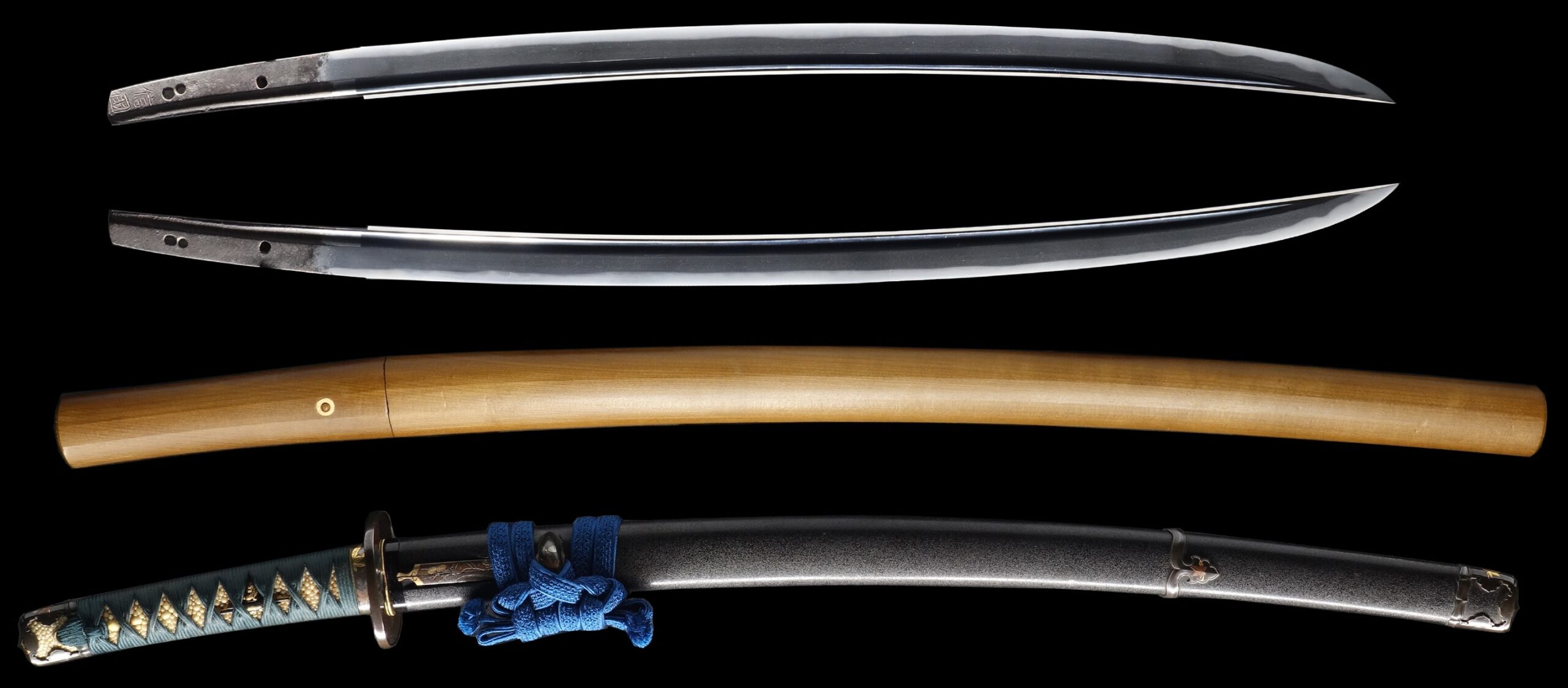
Hamon:
The crystalline structure which forms along the cutting edge of a blade as a result of the hardening process
Jimon(Jihada):
visible steel surface pattern created by folding and hammering during forging process
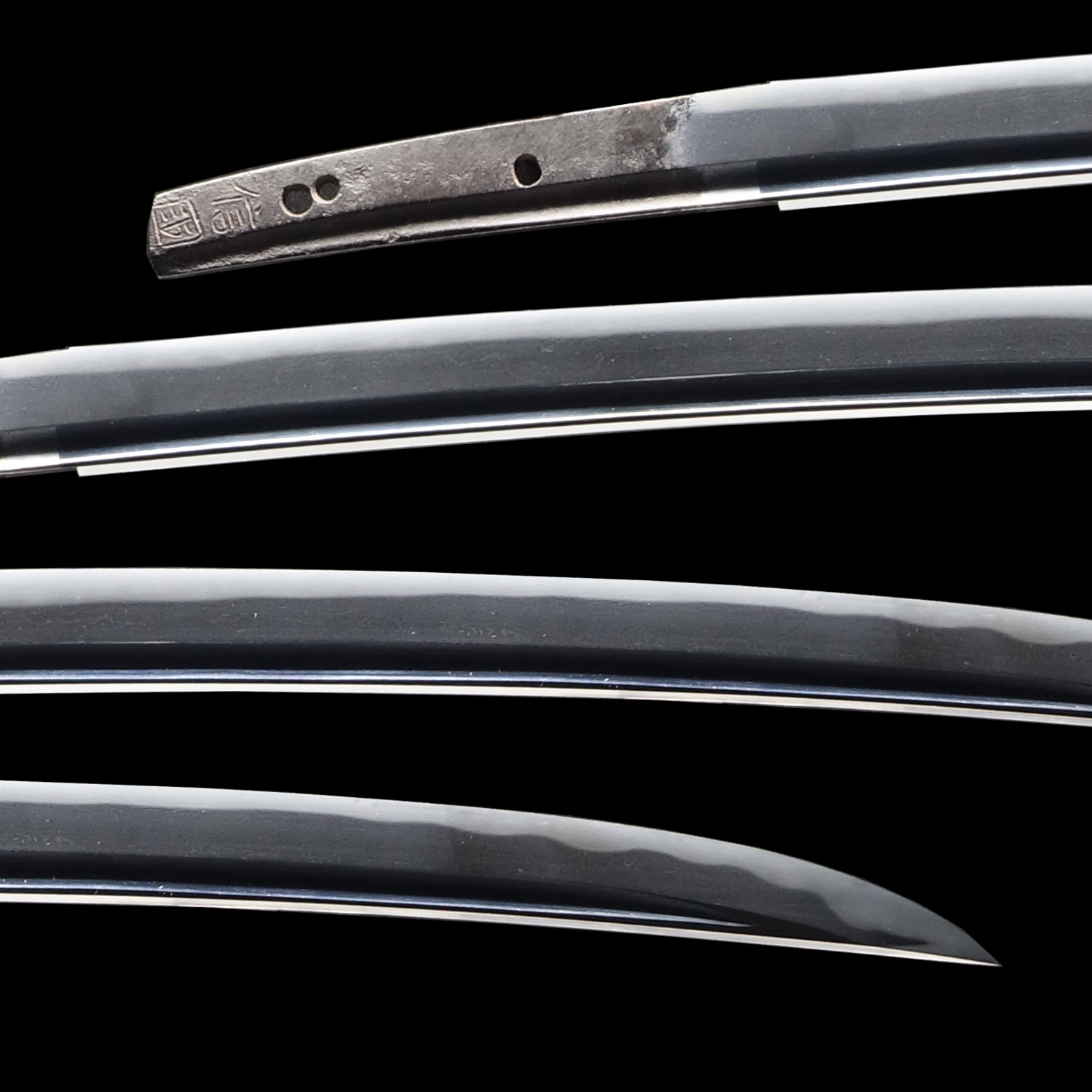
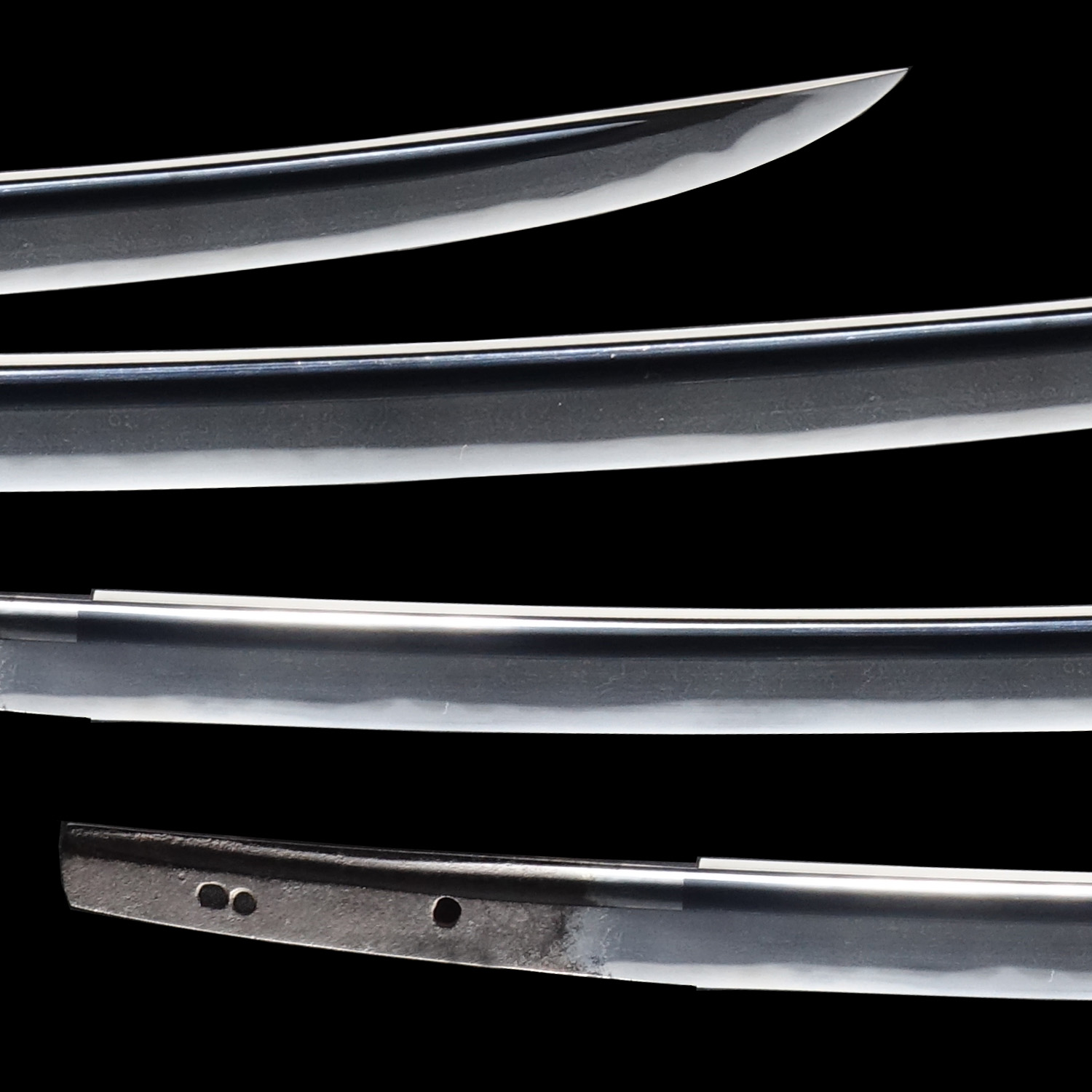

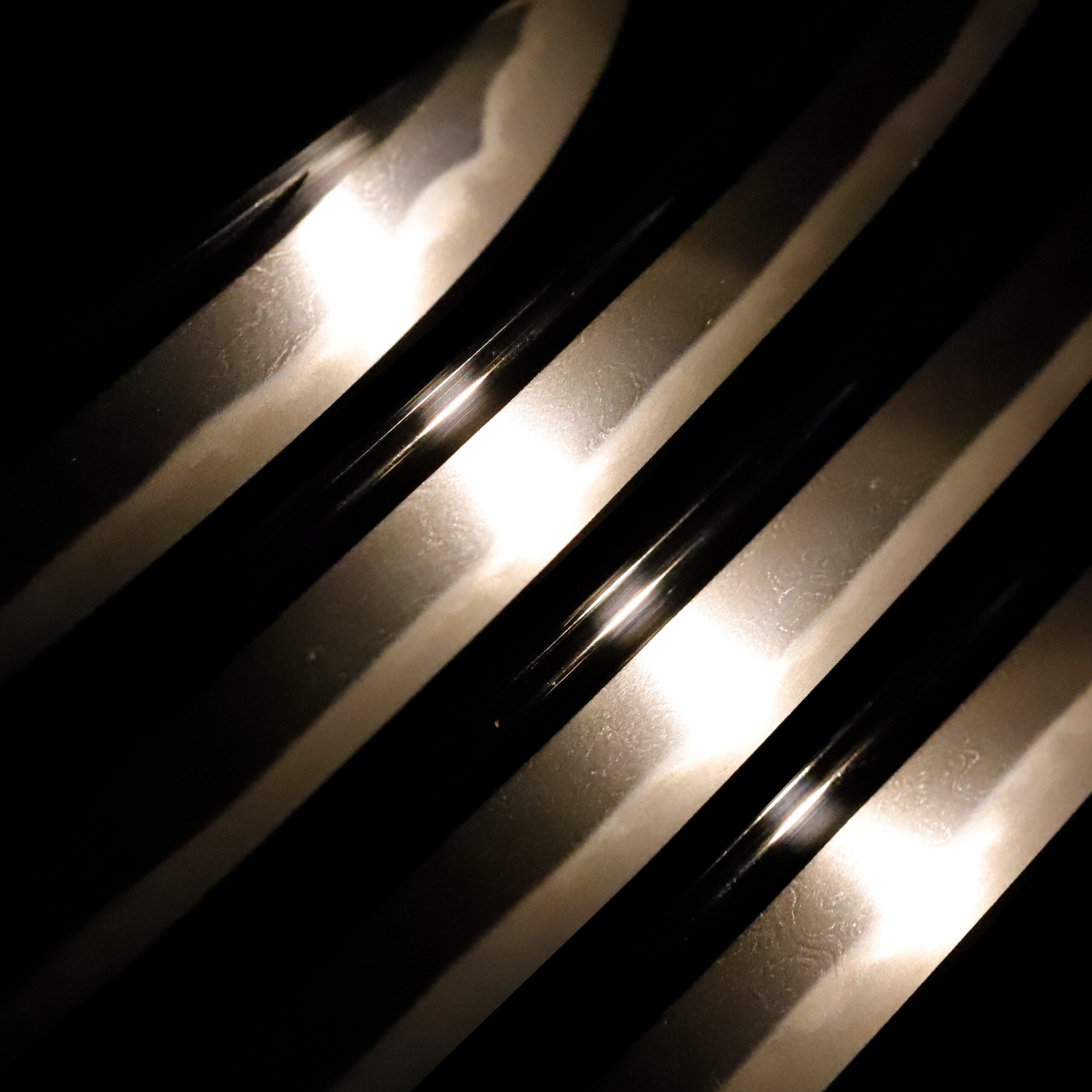


Nakago:Nakago is the tang of the Japanese sword.
Japanese swordsmiths left the black rust on the tang on purpose to prevent red rust while the tang is in its handle. And the discoloration of the tang was created over time, which is a great indicator for a Japanese sword specialist to estimate when the sword was forged.
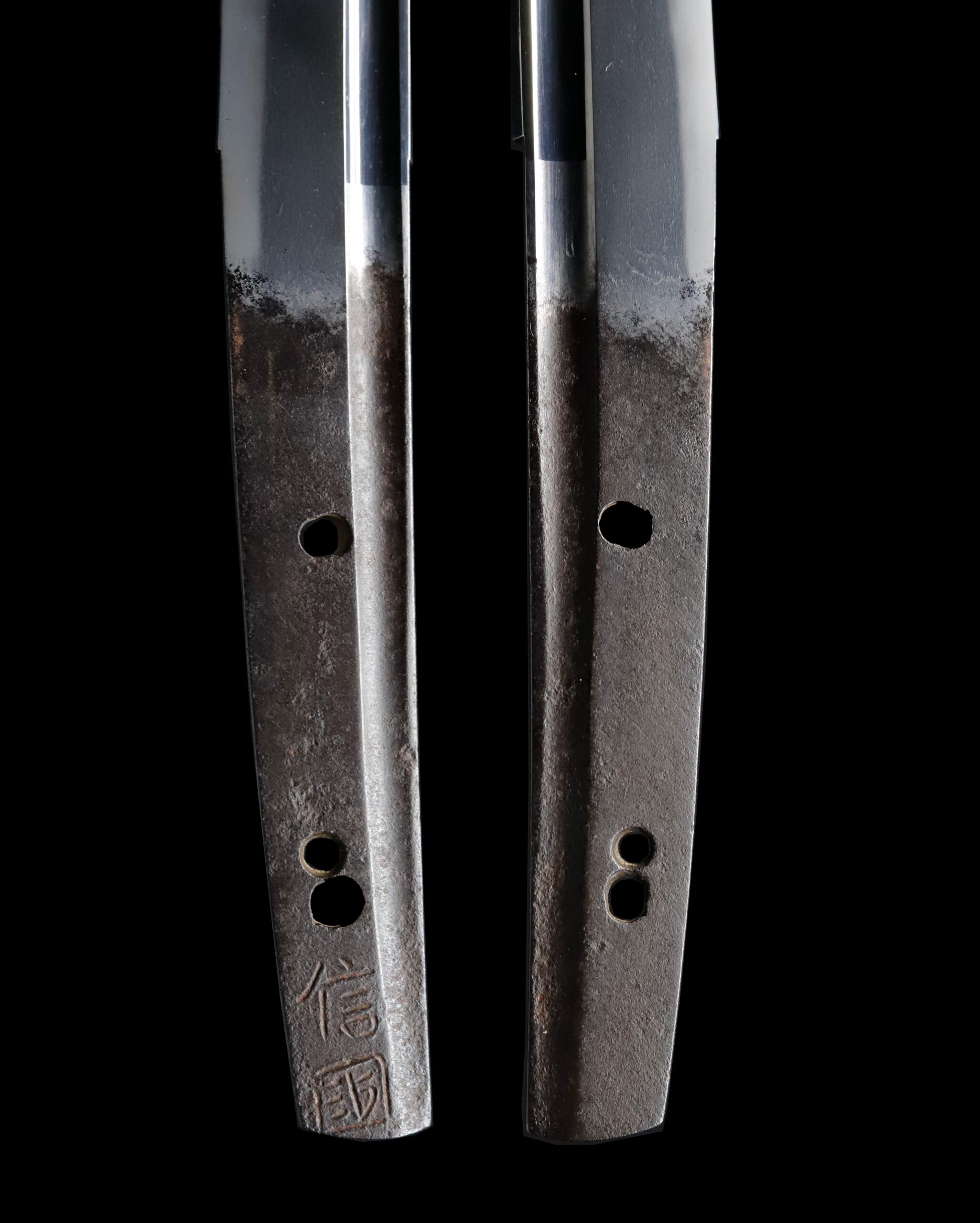
Koshirae: Koshirae is the mounting of the Japanese sword. There are several parts that consist of Koshirae such as Saya(Scabbard), Tsuka( Handle), Tsuba(Handguard).
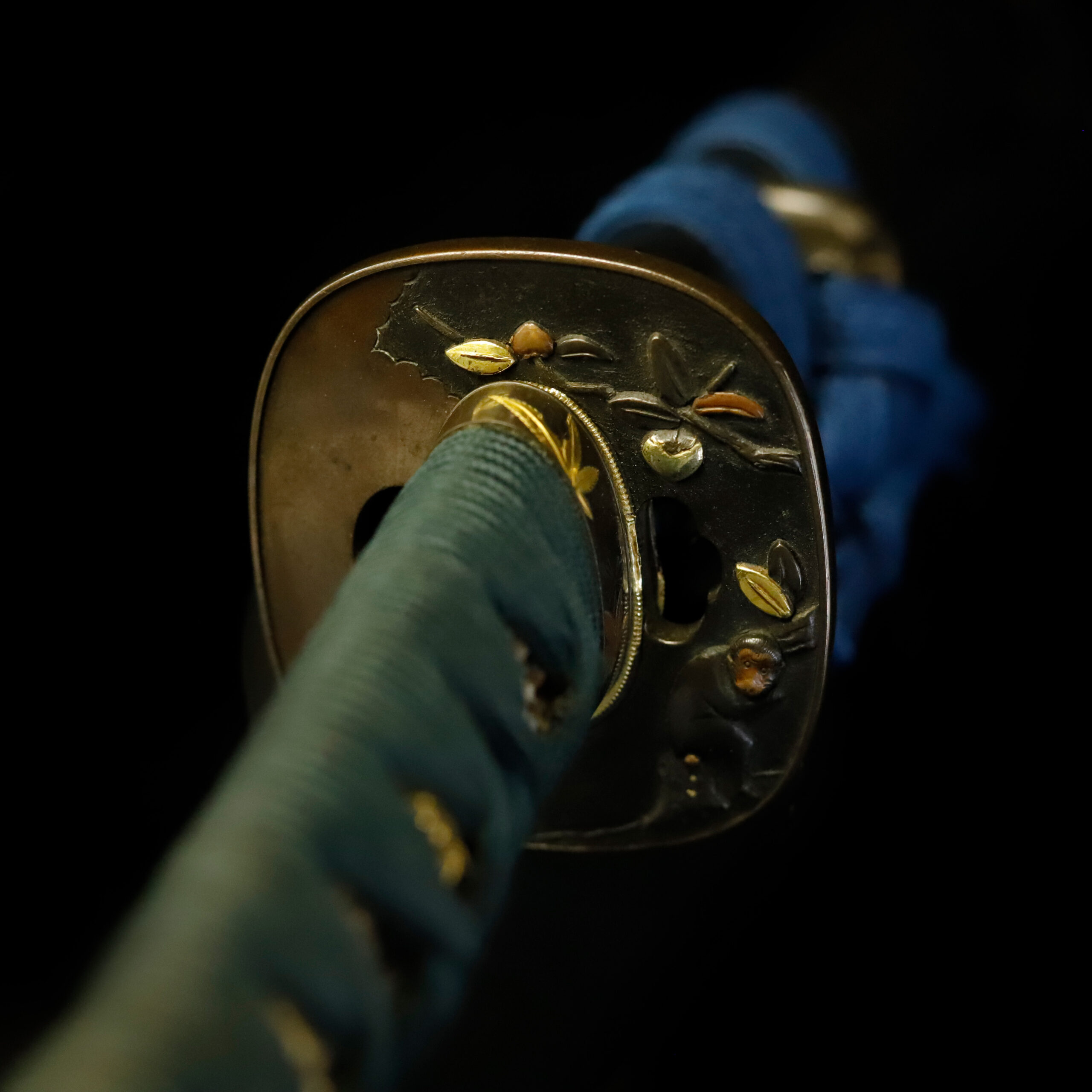
Fuchi-Kashira:A pair of matching sword fittings that cover the upper and bottom parts of its sword hilt.
The theme of this Fuchi Kashira is the Unkin Zu (雲錦図). It is the pattern that depicts cherry blossoms and maples together. It regards cherry blossoms are Kumo (雲, clouds) and maples are Nishiki (錦, brocade). In this design, We could see how Japanese people are emotionally moved by seasonal scenery, such as the feeling of loneliness from falling autumn leaves or the feeling of looking forward to spring when the cherry blossoms bloom. Both plants have been popular in Japan since ancient times and are valued as lucky charms. Cherry blossom is one of the seasonal things of spring. A theory says that the god of grain exists in cherry blossoms. Therefore, this flower pattern has been treated as the symbol of a plentiful harvest. In addition, maple patterns represent longevity.
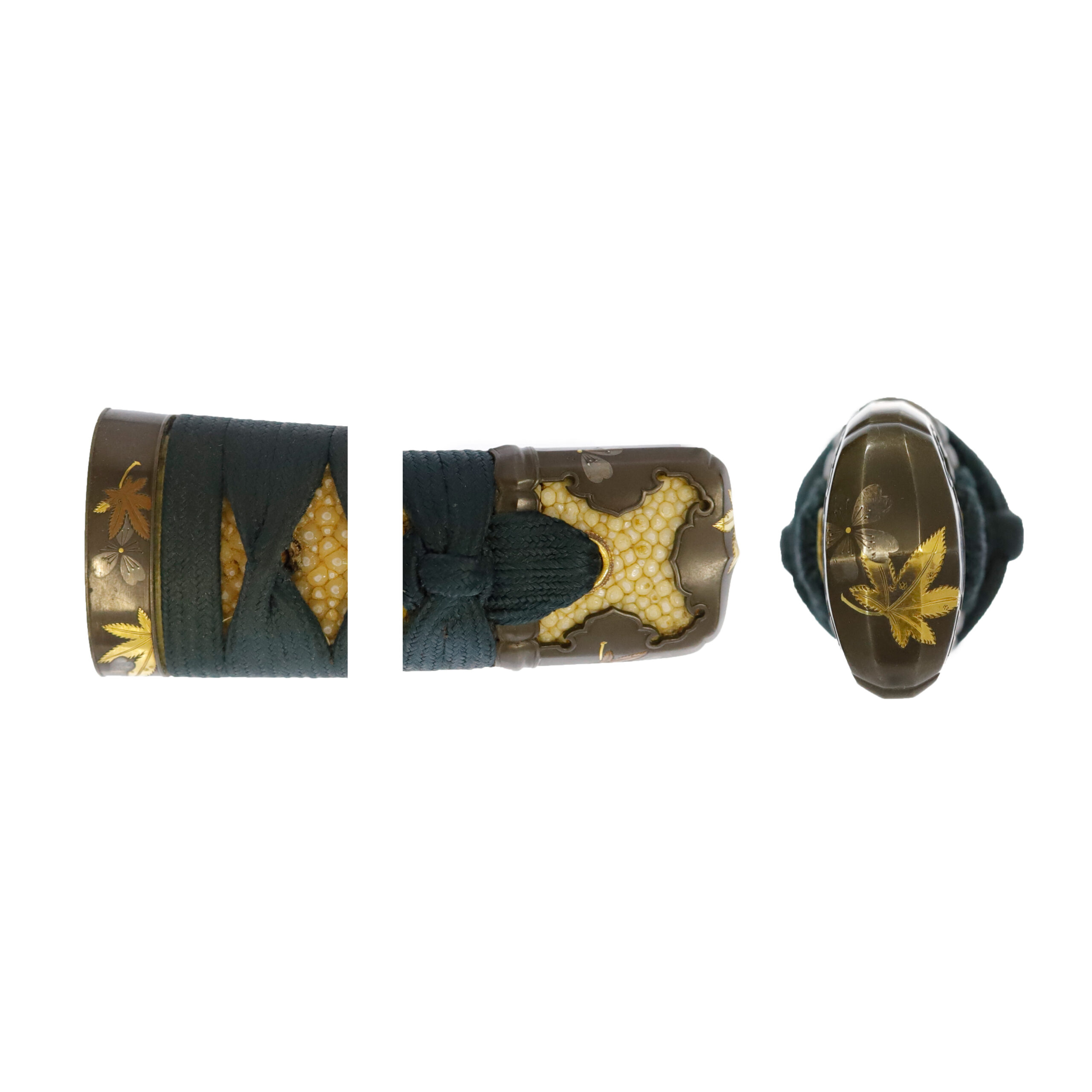
Tsuka and Menuki:Tsuka is the handle of the Japanese sword and Menuki is its decoration.
The motif of this Menuki is an incense burner. You would find an animal on top of each incense burner, and it is a sacred animal: Karajishi (唐獅子). The Shishi (獅子) means a lion in Japanese, and the Karajishi is a lion brought from the continent to Japan in the Toh period (唐, Tang dynasty, 618-907). The Karajishi typically has curly hair for its head, neck, body, and tail. In Buddhism, the Karajishi is regarded as a symbol of wisdom, and Monju Bosatu (文殊菩薩, Manjushri Bodhisattva) rides lions. According to a theory, the Karajishi is the origin of Komainu (狛犬, stone guardian dogs that exorcize evil spirits). It shows this beast motif has been familiar to Japanese people since ancient times. On this incense burner, you would also find that peony flowers are designed. The combination of Karajishi and peony is a classical theme that is described in a Houwa (法話, Buddhist monks tell the story of Buddhism in an easy-to-understand manner). The lion is called the king of the beasts. However, even this invincible animal has only one fear: a bug in the lion’s body. This pest grows in the lion’s hair, eventually breaking the skin and biting the flesh. Nevertheless, it dies if it is exposed to be the night dew of a peony. Therefore, the lion rests under peony flowers at night, looking for a haven. This Menuki’s design might have been quoted from this story.
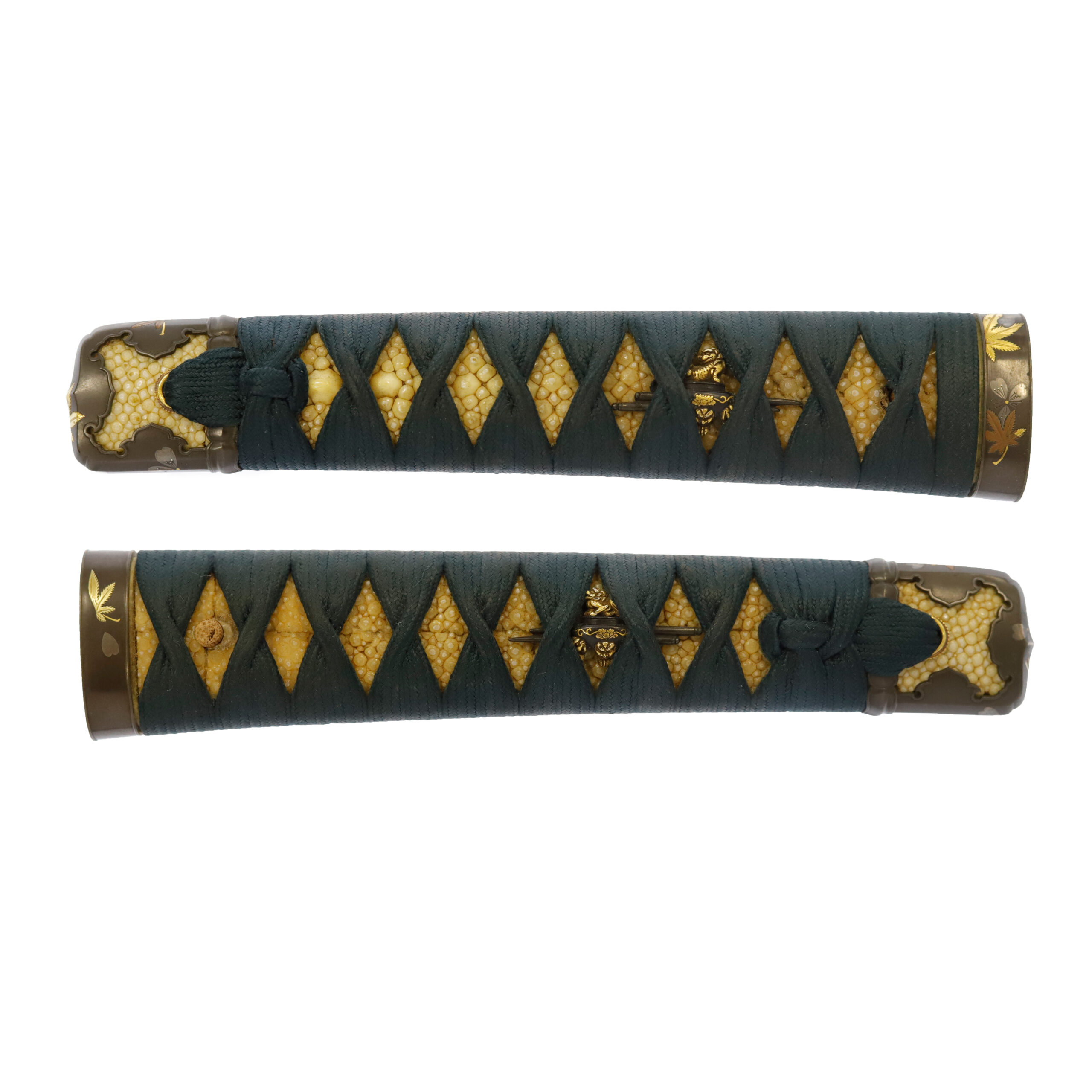
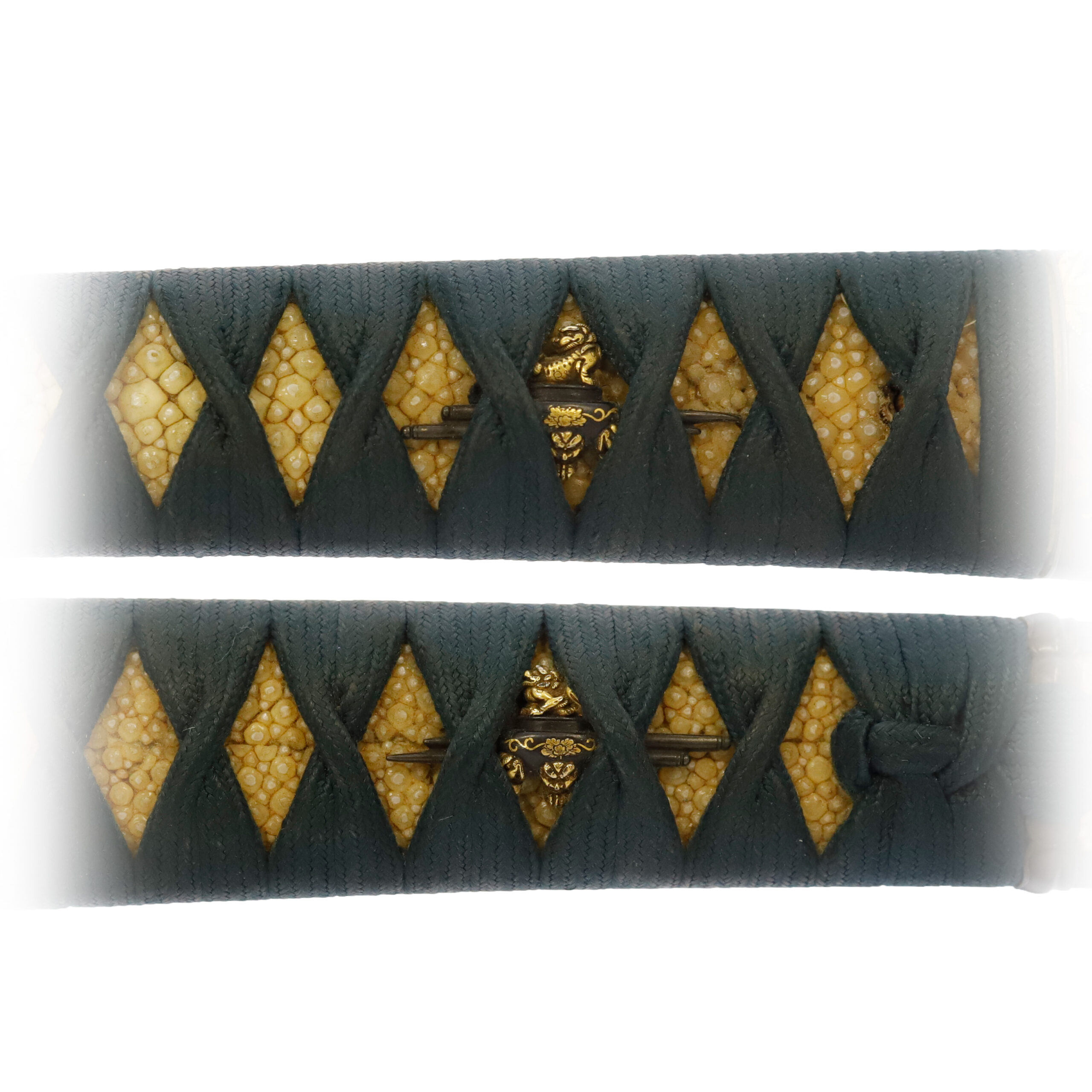
Tsuba and Habaki:Tsuba is the handguard for the Japanese Sword and Habaki is the equipment to make the blade not touch its scabbard inside. It prevents the blade from getting rusty and chipped.
This Tsuba depicts a figure of a monkey climbing a persimmon tree and looking down. Speaking of the combination of monkeys and chestnuts, it reminds us of a Japanese folktale called the Saru Kani Gassen (猿蟹合戦, The monkey and the crab). Although there are regional differences, the story’s outline is that of a cunning monkey who tricks and kills a crab and then gets revenge on the murdered crab cubs. Chestnuts burned the monkey by ramming it as part of the revenge against the monkey. It is unknown whether this story influenced this work. However, we hope such a perspective will increase the enjoyment of viewing.

Kozuka:Kozuka is a small knife stored in Kozuka Hitsu(groove of the sheath of the Japanese sword).
A Kogatana (小刀, small knife) is stored in the Kozuka. While there is a trace of an engraved inscription on this Kogatana, now it is challenging to read it due to aging. About the design, please focus on the man wearing Western clothing and holding a Gunpai/Gunbai (軍配, Sumo referee’s fan today). The Gunbai is a tool that is related to the Samurai culture. After the Ohnin-Bunmei era (応仁・文明年間, 1467-1487), military commanders used Gunbai-Uchiwa (軍配団扇) to encourage their subordinates by using it. Also, it was used for ordering the arrangement of an army: For example, the placement of troops, the date and time of the advance, and retreat. His clothing appears to be a type of so-called Nanban (南蛮) costume, and we think he was a Nanbanjin (南蛮人, Europeans who came to Japan from the Sengoku period to the early Edo period, either Portuguese or Spanish).
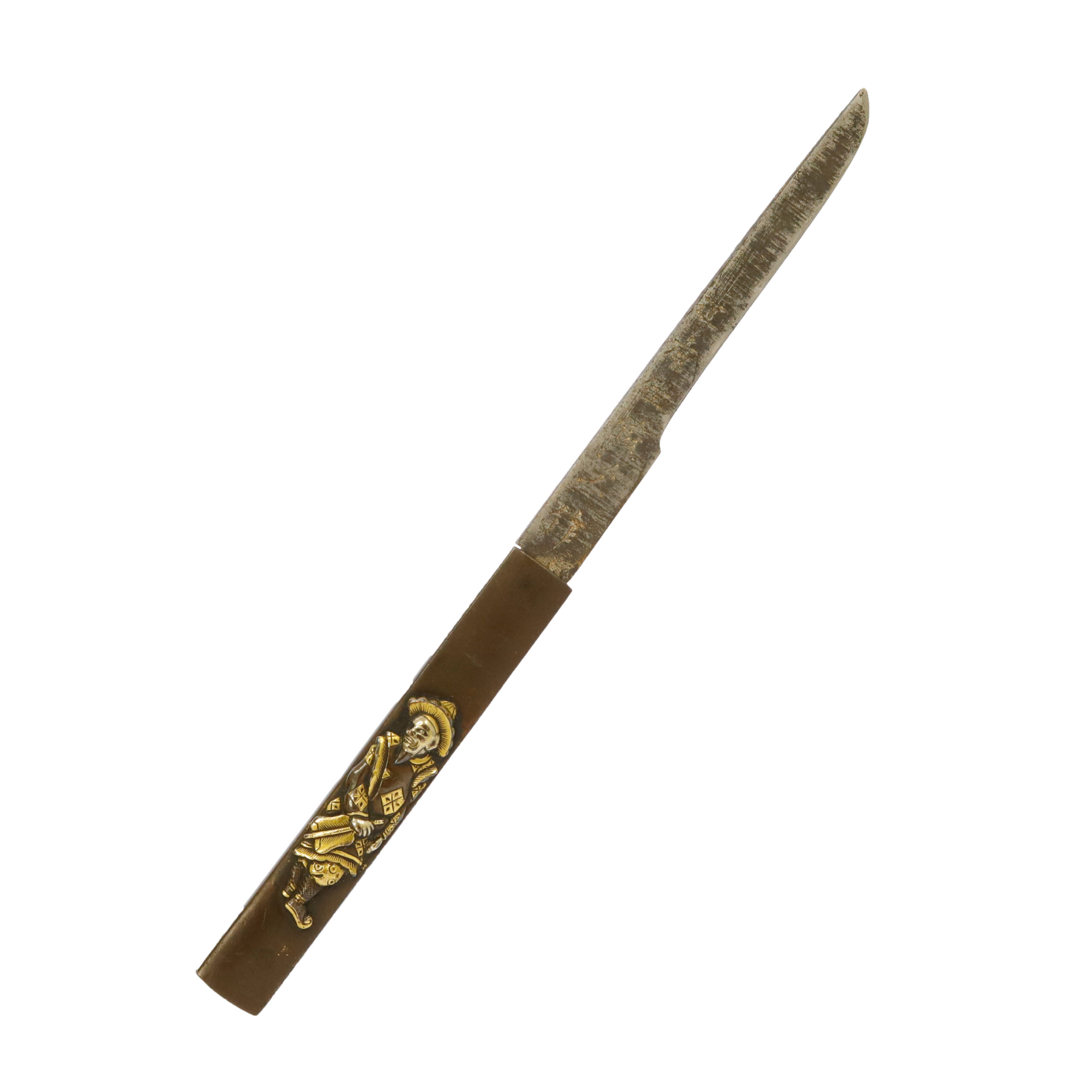
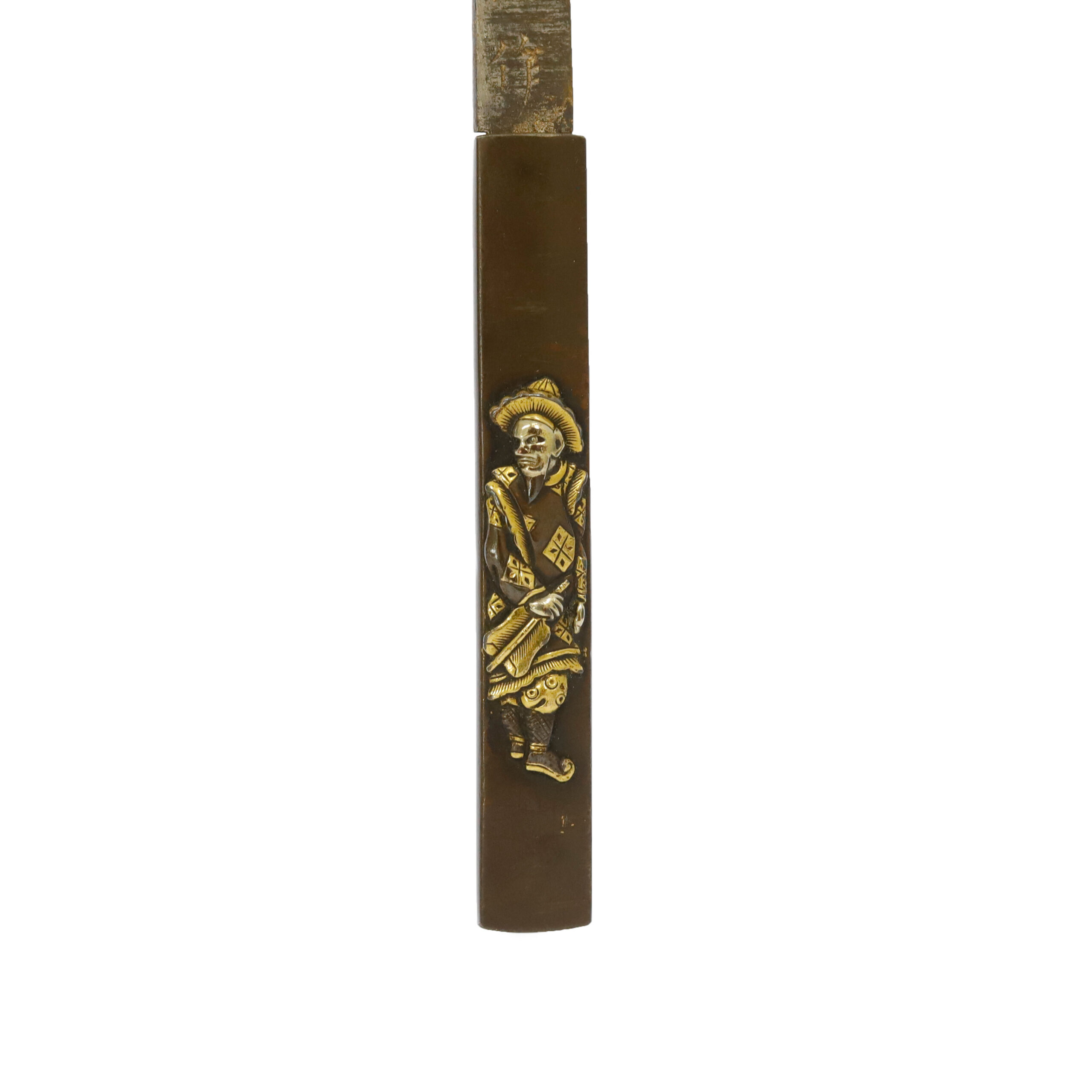
Kougai:Kougai is the equipment for Samurai to arrange or fix his hair style.
This item is an antique Kougai (笄), which was used to arrange or fix the hairstyle of Samurai. The Kougai is usually stored in the Kougai Hitsu. The Kozuka is often stored on the other side of the scabbard. This Kougai is separated into two parts, and this type of Kougai is categorized as the Wari Kougai (割笄). This separated type was invented in the Edo period, and it became popular as decorative metal fittings. A theory says some people used the Wari Kougai as chopsticks; however, there is no sure proof. Chrysanthemums are engraved on this Kougai, adding decorativeness to this work.

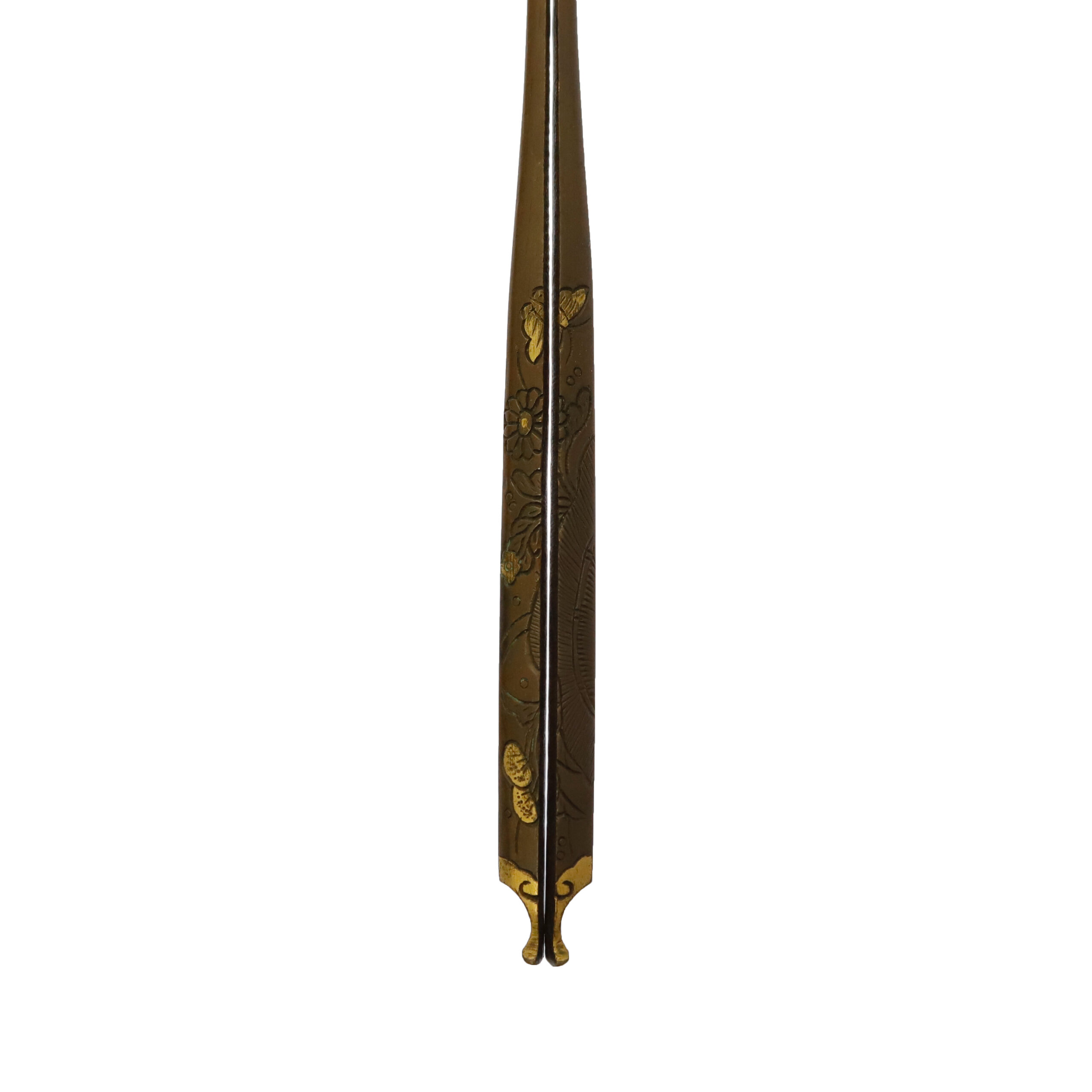
Saya: Saya is the scabbard for the Japanese sword.

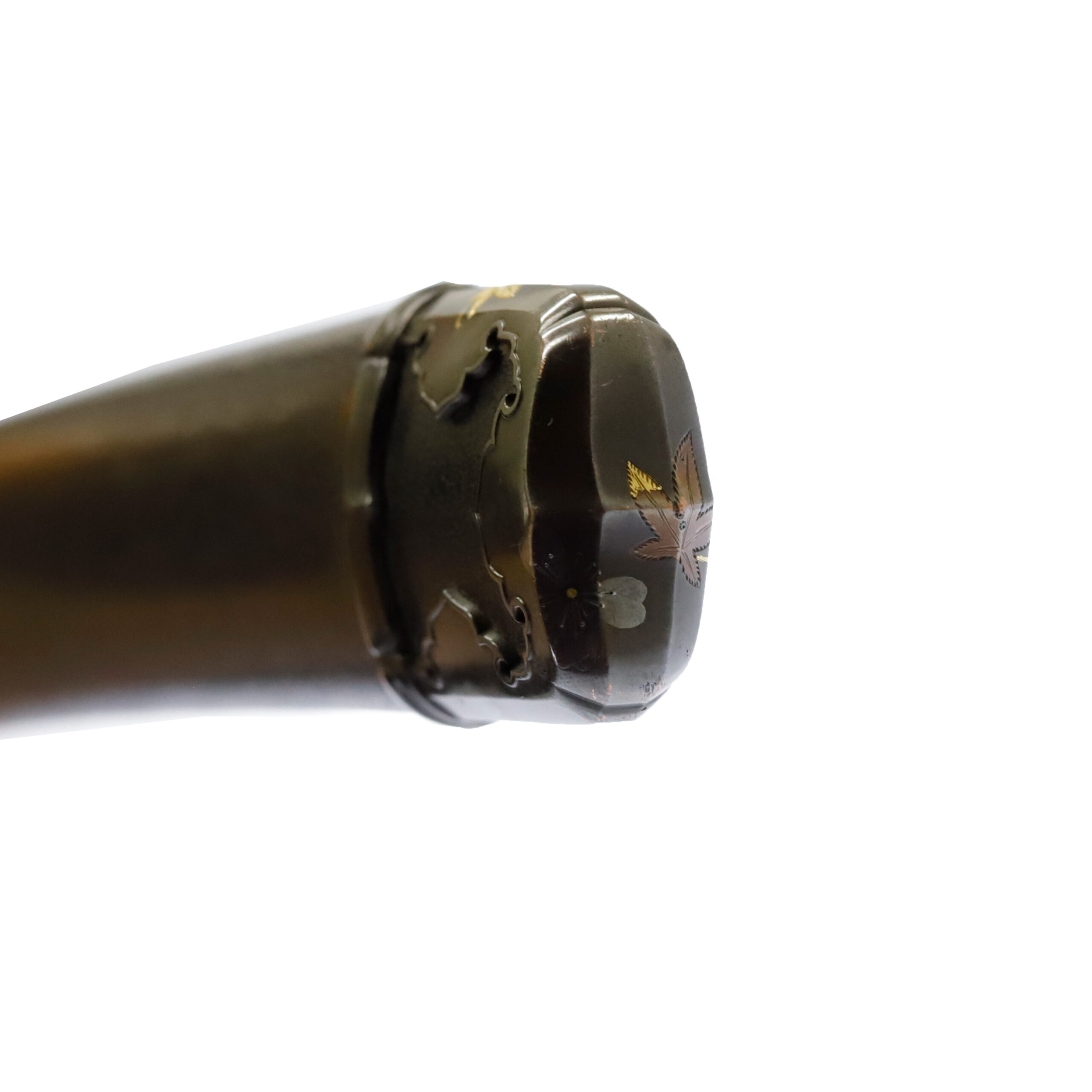
Authentication Paper:NBTHK Hozon Certificate for the blade (No. 351137) and Hozon Tosogu for the Koshirae (No.4019303)
NBTHK,, also known as Nihon Bijutsu Touken Hozon Kyokai (the Society for the Preservation of the Japan Art Sword), is one of the oldest Japanese sword appraising organizations in modern-day Japan. They authenticated the blade on October 5th in the 10th year of Heisei (1998) and the sword mounting on September 17th in the third year of the Reiwa (2021). They appraised it as Hozon Touken, the blade and Hozon Tosogu worth preserving for Japanese society. The purchaser will receive this original certificate as well. We can also translate what is written into English and make a PDF file for your record if you request.
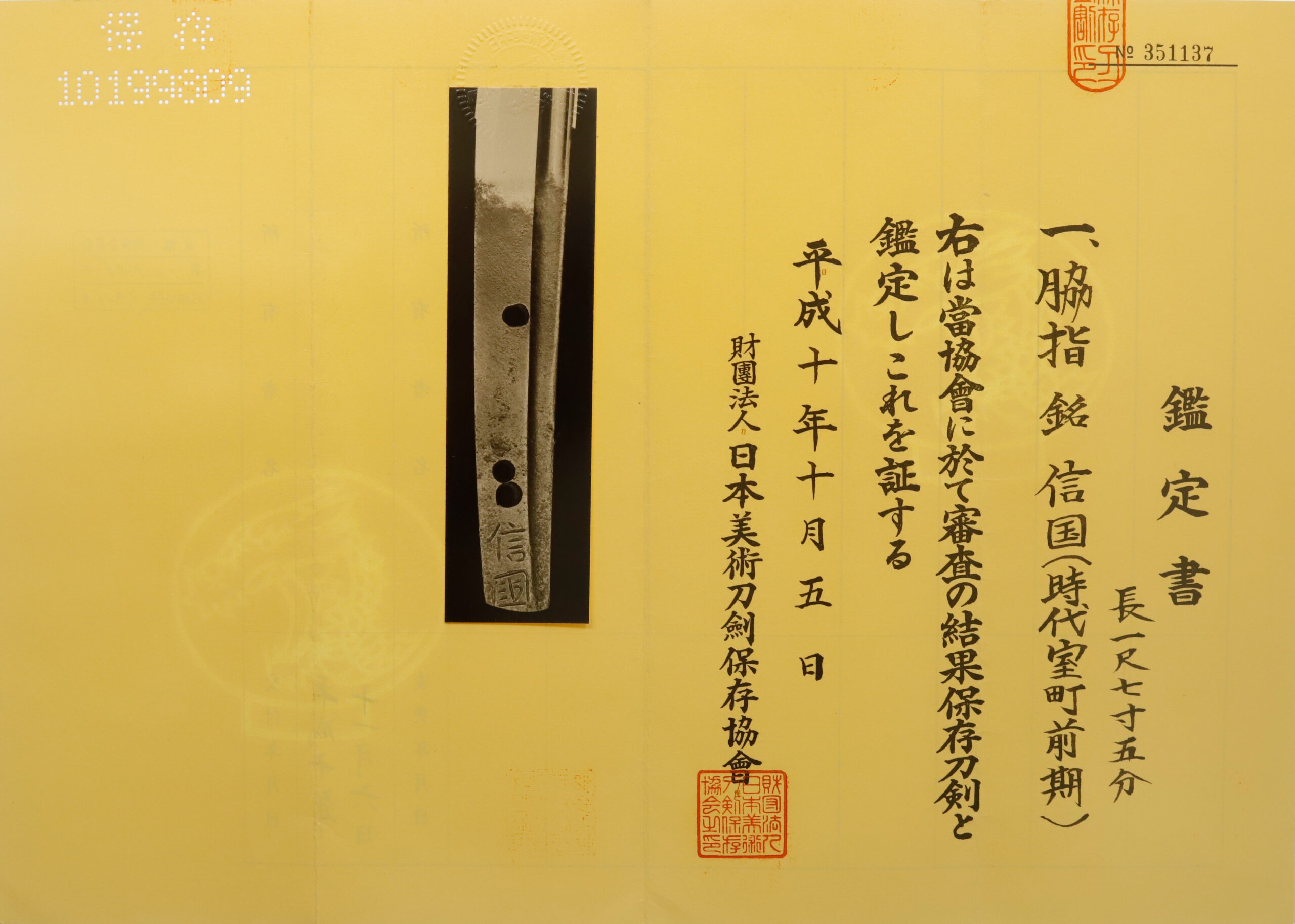
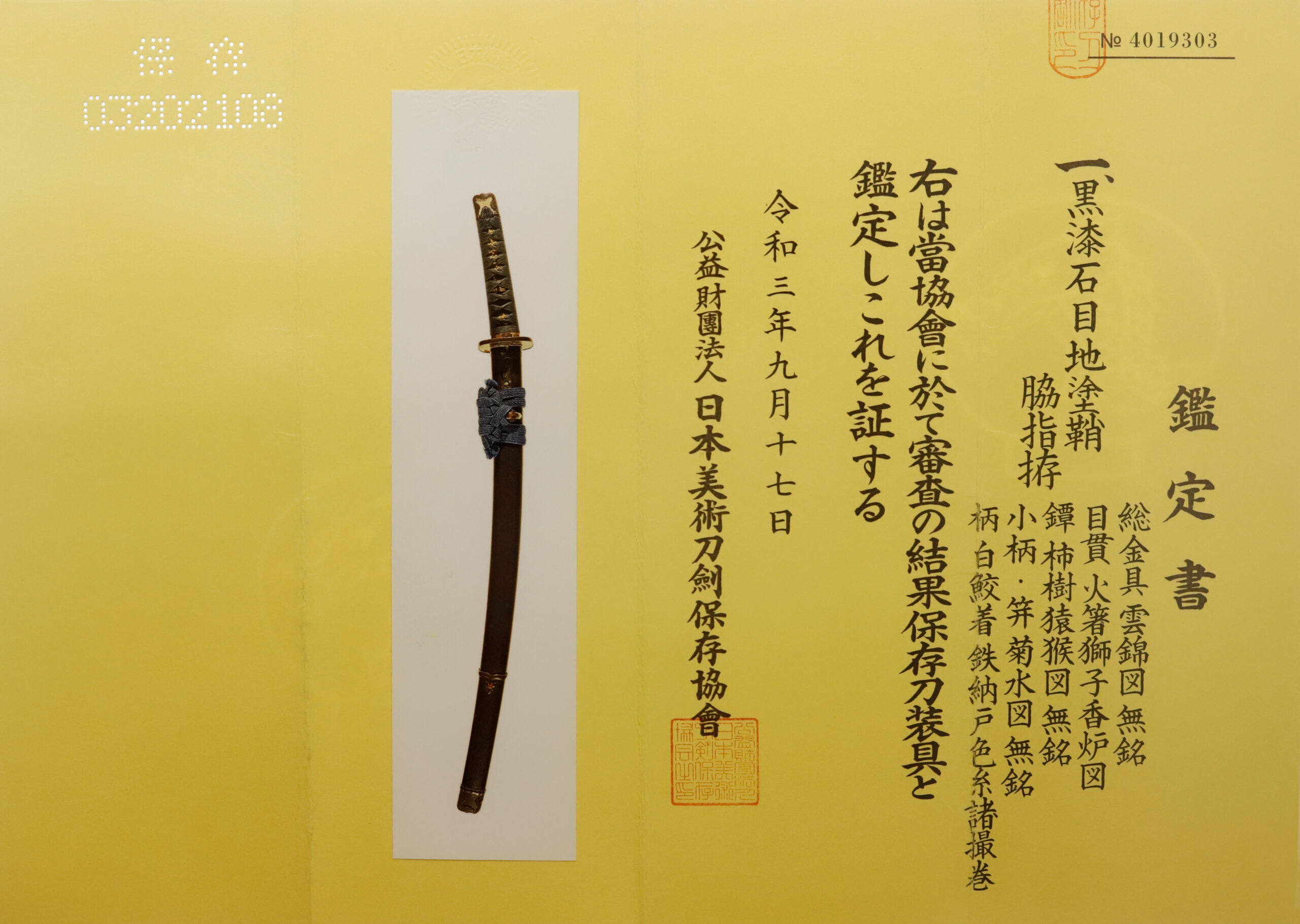
Registration Number : Tokyo 10945
The Board of Education in Tokyo prefecture issued a registration paper for this sword . It is called Jyu Token Rui Torokusho(銃刀剣類登録証). Bunkacho(The Agency for Cultural Affairs) acknowledges a Japanese sword with this paper as a work of art.
The sword needs to be traditionally hand-forged and made of Tamahagane carbon steel to be registered in the system. With this paper, its owner in Japan can legally own an authentic Japanese sword. Based on this registration number, we will apply for its export permit.
This paper will need to be returned to the board of education when the sword is being shipped abroad, but you can receive a copy of it. An English translation of this registration paper is available on request.


—————————————————————–
【About us】
Samurai Museum is located in Tokyo, Japan, exhibiting antique artifacts related to the Samurai history. Samurai Museum Shop is the place for those who are interested in Japanese culture and craftsmanship. We deal with antique Samurai swords/armor, traditional crafts made in Japan and so on.
【Japanese Sword& Export Process】
The Japanese swords we deal with are hand-forged edged swords made in Japan. It was made from the traditional carbon steel called TAMAHAGANE(玉鋼). Samurai Museum is familiar with the proper legal procedure for an antique/ authentic Japanese sword to be exported from Japan. We have sent more than 500 Japanese swords for the past three years (~2023) to amazing owners who appreciate its historical value.
Each Japanese sword is registered under the Agency for Cultural Affairs and the Board of Education in Japan. They issue a registration paper for each Japanese sword for its owner in Japan to legally possess it. The Japanese sword with its registration paper means it was traditionally hand-forged in Japan.
To legally export the sword from Japan to other countries, we will have to apply for its permit to the Agency for Cultural Affairs(Bunkacho) and return the original registration paper to the Board of Education. It normally takes around 2-4 weeks to receive this permit after submitting required documents. And we would like you to expect at least 1-1.5 months for your order to arrive at your given address after you ordered. For more detailed info, please click here.
It is allowed for residents in Japan to own authentic Japanese swords without a special license as long as they come with registration papers. Please feel free to contact us if you are a resident of Japan, whether temporarily or permanently. We will also assist you when you leave Japan and need to obtain the export permit.
【Payment Method】
We accept payment through Stripe (Credit card), PayPal, Apple Pay or ChromePay, all of which are secure payment methods. Also, you don’t need to make an account on Stripe for the checkout. If you prefer other payment method, please contact us. After confirming your payment, we will apply for an export permit. You may either pay in JPY, USD, AUD, CAD,EUR CHF or GBP. The price is set in Japanese Yen. Prices in other currencies are automatically calculated based on the latest exchange rate.

* If the amount is above 1 million JPY, Stripe or wire transfer will be the only options for payment.
【Shipping】
We have shipped authentic Japanese swords to the USA, UK, Canada, Mexico, Germany, France, Hong Kong and Australia. If you don’t live in these countries and like to order, please contact us first before making a purchase. We offer Free International Shipping as long as we can send antique Japanese swords by EMS.
We normally ship by EMS(Express Mail Service) provided by Japan Post. We will send you a tracking number for your order as soon as we hand it to the post office. We will put 100 % insurance on the shipping document without any extra charge. Based on the total amount, there might be a duty tax or other fee for you to pay, depending on the countries. We use package cushioning to protect the item and put it in a PVC pipe, which is one of the most secure packages because of its durability.
It will normally takes 5-14 days for the item to arrive at your given address after we dispatch it. Time of delivery is estimated as accurately as possible by the carrier but does not take into account any delays beyond our control such as by inclement weather, post office holiday seasons.
* If you live in Australia and like to purchase an authentic Japanese sword, please click here to know the detail.
*Please keep in mind that due to the spread of COVID-19, there might be delays in shipping. If you like to know the detail about shipping, please feel free to ask us.

【Review】
Here is one of the reviews we received from a customer who purchased an authentic Japanese sword from us. For more reviews, please click here.
“My experience overall with the whole process was wonderful. I had many questions about the history and process to purchase these treasures. All my questions were answered very timely and complete. The staff is very knowledgeable and very well versed if any questions do arise.”
【How to make sure the condition】
Please keep in mind that what you are going to purchase is an antique item. We uploaded high resolution photos for you to check its condition thoroughly. If you like to see more photos with different angles, please feel free to contact us. We will be happy to send them to you so that you can make informed decision. It is essential for us to know that you are happy with your choice of a sword. and we are prepared to use the best of our ability to serve you.
【How To Contact Us】
Please contact us through email, Facebook Messenger or Live Chat if you have any questions. You can find each icon on the right side of the website. Please click one of them to reach us. We will reply to you within 1-2 business days.
【The Art of Nihonto (Japanese Sword)】
Samurai’s history is a profound, eloquent legacy of ancient Japanese warriors in which millions of people worldwide are being fascinated. If you like to find out the art of Nihonto, please click here.
【A Guide to Japanese Sword Maintenance】
After acquiring an genuine Japanese sword, it is also important to know how to take good care of it. Here is the special video for you. Mr. Paul Martin, Japanese sword expert, shows you how to give proper maintenance to your sword. By mastering how to clean the Japanese sword, its aesthetic beauty will last forever.
When you purchase a Japanese sword from us, you can get a Free Japanese sword maintenance kit. It comes with four tools(Choji Oil, Uchiko Whetstone Powder, Peg remover, Oil Applicator). By watching the video instruction above , you can enjoy learning how to maintain your Japanese sword while appreciating it. If you have any difficulty assembling the sword or cleaning the blade, you can feel free to contact us.


MORE ANTIQUE JAPANESE SWORD FOR SALE
SWORDS WITHOUT CERTIFICATES FOR SALE
LEARN JAPANESE SWORD TERMINOLOGY
Thank you for reading all the information on the page. If you have any difficulty choosing the right Japanese sword for you, we will be more than happy to help you find the one that speaks to you the most. Please feel free to contact us.


